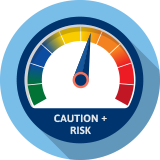October 16, 2018
L&S Risk Pulse™ Score

Caution +
The composite economic picture is mixed or unclear, indicating confusion in global markets. Valuations are questionable and volatility must be monitored.
L&S Risk Pulse™ Insights – “What, me worry??”
General Comments
The U.S. recovery, currently 114 months long, is the longest in history (the Ibbotson data goes back to 1926). It is one of the most profitable, although the run from 1990 to 2000 provided somewhat higher gains. Still, this has been a wonderful cycle in which to participate.
While the economic recovery has been long, it has actually been quite shallow. On average, post-war economic cycles have experienced about 49% GDP growth from the beginning of the cycle. Despite the length of this cycle, GDP growth has only expanded by 42%, somewhat below average. Other cycles that were longer showed dramatically greater expansions in GDP growth. This may be a reason to suggest that this cycle has further to go.
The data that we look for to support the market seems surprisingly intact. Over the long term, stock prices are driven by corporate earnings. Valuations ebb and flow, as does investor sentiment, but companies that grow earnings are likely to be rewarded with higher share prices. Here the news is exceptional. Over the past two quarters, S&P 500 company earnings have grown by 27% as compared to the same quarter last year. That growth is driven by higher margins emanating from the lower tax rates, higher revenue driven by solid economic growth, and corporate buybacks. As we enter the reporting season for the third calendar quarter, expectations are for similar growth again. Earnings growing at more than 20% in the 10th year of an expansion is an extraordinary occurrence. It is hard to find data that suggests this expansion is quickly coming to an end.
While we remain encouraged, we do see some signs that might suggest the market is getting tired. It is important to reinforce the fact that market corrections without recessions are much shallower and much less damaging. Still, we see some signs that give us a reason for some concern. Heavy IPO and merger and acquisition activity are signs that typically occur near a market top. Higher credit spreads and peaking operating margins are also signals that can suggest market turmoil. Fewer stocks participating and former leadership groups lagging can be indicators of a market that struggles. Still, there are no signs of speculation and of heavy retail affinity for the stock market, signals which can also be typical of market tops.
Conclusion
Signs of a recession remain missing. This bull market is one of the longest ever. It has been willing and able to climb the proverbial wall of worry. The Fed is tightening, but the market goes higher. The yield curve flattens, and the market goes higher. Trump is elected and the market advances. Supreme court nominees are heavily scrutinized and the market ignores the distraction. Midterm elections are on the horizon, but the market recognizes the outcome is a return to the normalcy of a divided government.
Corporate earnings are strong, and confidence is high. Economic growth remains robust especially here in the US. Valuations are middling, and this expansion is one of the longest in history. Still, we recognize that expansions do not die of old age. Expansions typically end with policy mistakes or external shocks. The Fed is raising rates, but the pace of these increases is as shallow as in any time in the past 50 years. A correction is possible for stock market investors, but any correction that might occur is likely to be fairly mild.
It is easy to get distracted by political noise. The market does not care about the outcome of the mid-term election, and neither should we. L&S ignores the partisanship and focuses on the potential for mankind to make amazing advances over the next few decades. Finding some of these themes and investing in them is likely to provide solid returns. This is where our focus continues to be.
Epilogue
On October 11th, the Risk Pulse was raised from Caution (5 of 10) to Caution+ (6 of 10).
Much of the data that seems to have spooked the market is not different from what we have seen over the past several months. Why do interest rate increases matter now when the Fed has been transparent about its intent all year? Why do worries about European banks matter now when these stories have been recirculating since 2012? It is impossible to know, but we do know that the market’s behavior has been different over the past couple of weeks.
The biggest discrepancy in the economic data is the fact that the US economy remains robust while the European and Chinese economies have slowed this year. That does not suggest that those economies are declining, but we have seen a noticeable decline in the rate of growth, and that alone creates a greater risk that one or more of those economies will slip into recession. We live in a global market, and at some point it is likely that the international and US economies will again become more synchronized. Does that mean that the US will slow down to catch up with the rest of the world, or does it mean that international markets will pick-up. We simply do not know the answer.
The IMF recently cited trade concerns as a reason for lowering global growth estimates, so perhaps the more likely outcome is the US slows to coincide with our global partners, and that is a concern that could easily push markets lower.
It is with this in mind that we increased the Risk Pulse to Caution+ (6) from Caution (5).
